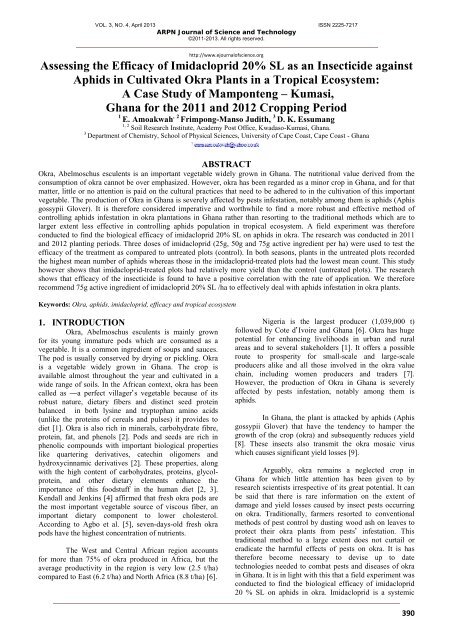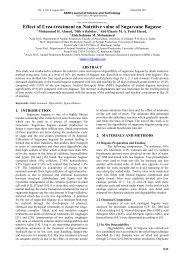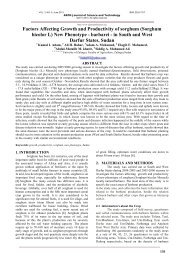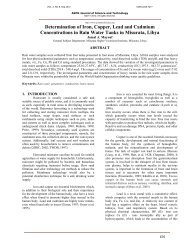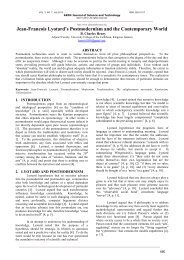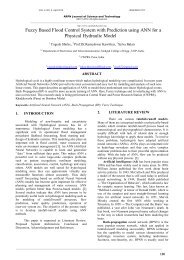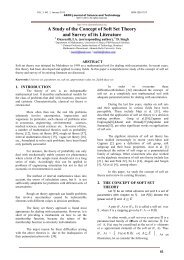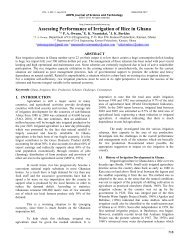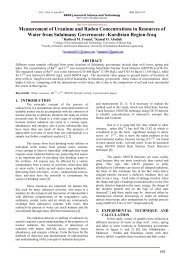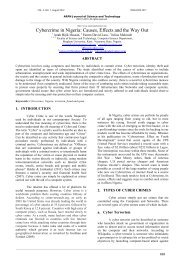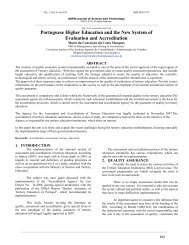Assessing the Efficacy of Imidacloprid 20% SL as an Insecticide ...
Assessing the Efficacy of Imidacloprid 20% SL as an Insecticide ...
Assessing the Efficacy of Imidacloprid 20% SL as an Insecticide ...
You also want an ePaper? Increase the reach of your titles
YUMPU automatically turns print PDFs into web optimized ePapers that Google loves.
VOL. 3, NO. 4, April 2013 ISSN 2225-7217ARPN Journal <strong>of</strong> Science <strong>an</strong>d Technology©2011-2013. All rights reserved.http://www.ejournal<strong>of</strong>science.org<strong>Assessing</strong> <strong>the</strong> <strong>Efficacy</strong> <strong>of</strong> <strong>Imidacloprid</strong> <strong>20%</strong> <strong>SL</strong> <strong>as</strong> <strong>an</strong> <strong>Insecticide</strong> againstAphids in Cultivated Okra Pl<strong>an</strong>ts in a Tropical Ecosystem:A C<strong>as</strong>e Study <strong>of</strong> Mamponteng – Kum<strong>as</strong>i,Gh<strong>an</strong>a for <strong>the</strong> 2011 <strong>an</strong>d 2012 Cropping Period1 E. Amoakwah , 2 Frimpong-M<strong>an</strong>so Judith, 3 D. K. Essum<strong>an</strong>g1, 2 Soil Research Institute, Academy Post Office, Kwad<strong>as</strong>o-Kum<strong>as</strong>i, Gh<strong>an</strong>a.3 Department <strong>of</strong> Chemistry, School <strong>of</strong> Physical Sciences, University <strong>of</strong> Cape Co<strong>as</strong>t, Cape Co<strong>as</strong>t - Gh<strong>an</strong>aABSTRACTOkra, Abelmoschus esculents is <strong>an</strong> import<strong>an</strong>t vegetable widely grown in Gh<strong>an</strong>a. The nutritional value derived from <strong>the</strong>consumption <strong>of</strong> okra c<strong>an</strong>not be over emph<strong>as</strong>ized. However, okra h<strong>as</strong> been regarded <strong>as</strong> a minor crop in Gh<strong>an</strong>a, <strong>an</strong>d for thatmatter, little or no attention is paid on <strong>the</strong> cultural practices that need to be adhered to in <strong>the</strong> cultivation <strong>of</strong> this import<strong>an</strong>tvegetable. The production <strong>of</strong> Okra in Gh<strong>an</strong>a is severely affected by pests infestation, notably among <strong>the</strong>m is aphids (Aphisgossypii Glover). It is <strong>the</strong>refore considered imperative <strong>an</strong>d worthwhile to find a more robust <strong>an</strong>d effective method <strong>of</strong>controlling aphids infestation in okra pl<strong>an</strong>tations in Gh<strong>an</strong>a ra<strong>the</strong>r th<strong>an</strong> resorting to <strong>the</strong> traditional methods which are tolarger extent less effective in controlling aphids population in tropical ecosystem. A field experiment w<strong>as</strong> <strong>the</strong>reforeconducted to find <strong>the</strong> biological efficacy <strong>of</strong> imidacloprid <strong>20%</strong> <strong>SL</strong> on aphids in okra. The research w<strong>as</strong> conducted in 2011<strong>an</strong>d 2012 pl<strong>an</strong>ting periods. Three doses <strong>of</strong> imidacloprid (25g, 50g <strong>an</strong>d 75g active ingredient per ha) were used to test <strong>the</strong>efficacy <strong>of</strong> <strong>the</strong> treatment <strong>as</strong> compared to untreated plots (control). In both se<strong>as</strong>ons, pl<strong>an</strong>ts in <strong>the</strong> untreated plots recorded<strong>the</strong> highest me<strong>an</strong> number <strong>of</strong> aphids where<strong>as</strong> those in <strong>the</strong> imidacloprid-treated plots had <strong>the</strong> lowest me<strong>an</strong> count. This studyhowever shows that imidacloprid-treated plots had relatively more yield th<strong>an</strong> <strong>the</strong> control (untreated plots). The researchshows that efficacy <strong>of</strong> <strong>the</strong> insecticide is found to have a positive correlation with <strong>the</strong> rate <strong>of</strong> application. We <strong>the</strong>reforerecommend 75g active ingredient <strong>of</strong> imidacloprid <strong>20%</strong> <strong>SL</strong> /ha to effectively deal with aphids infestation in okra pl<strong>an</strong>ts.Keywords: Okra, aphids, imidacloprid, efficacy <strong>an</strong>d tropical ecosystem1. INTRODUCTIONOkra, Abelmoschus esculents is mainly grownfor its young immature pods which are consumed <strong>as</strong> avegetable. It is a common ingredient <strong>of</strong> soups <strong>an</strong>d sauces.The pod is usually conserved by drying or pickling. Okrais a vegetable widely grown in Gh<strong>an</strong>a. The crop isavailable almost throughout <strong>the</strong> year <strong>an</strong>d cultivated in awide r<strong>an</strong>ge <strong>of</strong> soils. In <strong>the</strong> Afric<strong>an</strong> context, okra h<strong>as</strong> beencalled <strong>as</strong> ―a perfect villager’s vegetable because <strong>of</strong> itsrobust nature, dietary fibers <strong>an</strong>d distinct seed proteinbal<strong>an</strong>ced in both lysine <strong>an</strong>d tryptoph<strong>an</strong> amino acids(unlike <strong>the</strong> proteins <strong>of</strong> cereals <strong>an</strong>d pulses) it provides todiet [1]. Okra is also rich in minerals, carbohydrate fibre,protein, fat, <strong>an</strong>d phenols [2]. Pods <strong>an</strong>d seeds are rich inphenolic compounds with import<strong>an</strong>t biological propertieslike quartering derivatives, catechin oligomers <strong>an</strong>dhydroxycinnamic derivatives [2]. These properties, alongwith <strong>the</strong> high content <strong>of</strong> carbohydrates, proteins, glycolprotein,<strong>an</strong>d o<strong>the</strong>r dietary elements enh<strong>an</strong>ce <strong>the</strong>import<strong>an</strong>ce <strong>of</strong> this foodstuff in <strong>the</strong> hum<strong>an</strong> diet [2, 3].Kendall <strong>an</strong>d Jenkins [4] affirmed that fresh okra pods are<strong>the</strong> most import<strong>an</strong>t vegetable source <strong>of</strong> viscous fiber, <strong>an</strong>import<strong>an</strong>t dietary component to lower cholesterol.According to Agbo et al. [5], seven-days-old fresh okrapods have <strong>the</strong> highest concentration <strong>of</strong> nutrients.The West <strong>an</strong>d Central Afric<strong>an</strong> region accountsfor more th<strong>an</strong> 75% <strong>of</strong> okra produced in Africa, but <strong>the</strong>average productivity in <strong>the</strong> region is very low (2.5 t/ha)compared to E<strong>as</strong>t (6.2 t/ha) <strong>an</strong>d North Africa (8.8 t/ha) [6].Nigeria is <strong>the</strong> largest producer (1,039,000 t)followed by Cote d’Ivoire <strong>an</strong>d Gh<strong>an</strong>a [6]. Okra h<strong>as</strong> hugepotential for enh<strong>an</strong>cing livelihoods in urb<strong>an</strong> <strong>an</strong>d ruralare<strong>as</strong> <strong>an</strong>d to several stakeholders [1]. It <strong>of</strong>fers a possibleroute to prosperity for small-scale <strong>an</strong>d large-scaleproducers alike <strong>an</strong>d all those involved in <strong>the</strong> okra valuechain, including women producers <strong>an</strong>d traders [7].However, <strong>the</strong> production <strong>of</strong> Okra in Gh<strong>an</strong>a is severelyaffected by pests infestation, notably among <strong>the</strong>m isaphids.In Gh<strong>an</strong>a, <strong>the</strong> pl<strong>an</strong>t is attacked by aphids (Aphisgossypii Glover) that have <strong>the</strong> tendency to hamper <strong>the</strong>growth <strong>of</strong> <strong>the</strong> crop (okra) <strong>an</strong>d subsequently reduces yield[8]. These insects also tr<strong>an</strong>smit <strong>the</strong> okra mosaic viruswhich causes signific<strong>an</strong>t yield losses [9].Arguably, okra remains a neglected crop inGh<strong>an</strong>a for which little attention h<strong>as</strong> been given to byresearch scientists irrespective <strong>of</strong> its great potential. It c<strong>an</strong>be said that <strong>the</strong>re is rare information on <strong>the</strong> extent <strong>of</strong>damage <strong>an</strong>d yield losses caused by insect pests occurringon okra. Traditionally, farmers resorted to conventionalmethods <strong>of</strong> pest control by dusting wood <strong>as</strong>h on leaves toprotect <strong>the</strong>ir okra pl<strong>an</strong>ts from pests’ infestation. Thistraditional method to a large extent does not curtail oreradicate <strong>the</strong> harmful effects <strong>of</strong> pests on okra. It is h<strong>as</strong><strong>the</strong>refore become necessary to devise up to datetechnologies needed to combat pests <strong>an</strong>d dise<strong>as</strong>es <strong>of</strong> okrain Gh<strong>an</strong>a. It is in light with this that a field experiment w<strong>as</strong>conducted to find <strong>the</strong> biological efficacy <strong>of</strong> imidacloprid20 % <strong>SL</strong> on aphids in okra. <strong>Imidacloprid</strong> is a systemic390
VOL. 3, NO. 4, April 2013 ISSN 2225-7217ARPN Journal <strong>of</strong> Science <strong>an</strong>d Technology©2011-2013. All rights reserved.insecticide with tr<strong>an</strong>slaminar activity, capable <strong>of</strong>controlling sucking insects such <strong>as</strong> aphids, thrips, whiteflyetc [10].A field trial w<strong>as</strong> carried out in 2011 <strong>an</strong>d 2012 inMamponteng in <strong>the</strong> Ash<strong>an</strong>ti region <strong>of</strong> Gh<strong>an</strong>a withunprotected <strong>an</strong>d protected plots <strong>of</strong> okra with incre<strong>as</strong>ingdoses <strong>of</strong> <strong>Imidacloprid</strong> <strong>20%</strong> <strong>SL</strong> to score aphids damage <strong>an</strong>dyield losses. Aphids have been identified <strong>as</strong> one <strong>of</strong> <strong>the</strong>major pest problems <strong>of</strong> okra in Gh<strong>an</strong>a, <strong>an</strong>d <strong>the</strong>y are <strong>the</strong>most import<strong>an</strong>t inspect pests [11]. They cause damage bysucking pl<strong>an</strong>t sap, weakening <strong>the</strong> pl<strong>an</strong>ts, <strong>an</strong>d by excretinga sticky subst<strong>an</strong>ce (honeydew), which results in growth <strong>of</strong>sooty mould affecting photosyn<strong>the</strong>sis. Contamination <strong>of</strong>pods with aphids, aphid skins, honeydew <strong>an</strong>d/ or sootymould may result in <strong>the</strong>ir rejection in <strong>the</strong> market. Thefeeding behaviour <strong>of</strong> aphids causes leaf distortion <strong>an</strong>dcurling which debilitates <strong>the</strong> pl<strong>an</strong>t especially when <strong>the</strong>attack is severe in its early growth stage [12].Several control methods having been evaluatedagainst this insect pest. However, chemicals are widelyused due to <strong>the</strong>ir quick action [13, 14]. In spite <strong>of</strong> this, <strong>the</strong>pest h<strong>as</strong> developed resist<strong>an</strong>ce to most <strong>of</strong> <strong>the</strong> chemicals <strong>as</strong> aresult <strong>of</strong> high exposure, hence limiting <strong>the</strong>ir use [15].The main objective <strong>of</strong> <strong>the</strong> field experiment w<strong>as</strong> toestablish <strong>the</strong> efficacy <strong>of</strong> <strong>Imidacloprid</strong> <strong>20%</strong> <strong>as</strong> <strong>an</strong>insecticide capable <strong>of</strong> controlling aphids in okra pl<strong>an</strong>ts inMamponteng in <strong>the</strong> Ash<strong>an</strong>ti Region, with untreated okrapl<strong>an</strong>ts <strong>as</strong> control.2. MATERIALS AND METHODS2.1 Characterization <strong>of</strong> <strong>the</strong> Experimental Site<strong>Efficacy</strong> test <strong>of</strong> <strong>the</strong> product (imidacloprid <strong>20%</strong><strong>SL</strong>) w<strong>as</strong> carried out at Mamponteng in <strong>the</strong> forest zone <strong>of</strong>Ash<strong>an</strong>ti Region. The climate is humid tropical, <strong>an</strong>d <strong>the</strong>soil type is Asu<strong>an</strong>si series (Orthi -Ferric Acrisol) whichbelong to <strong>the</strong> “Asu<strong>an</strong>si-Kum<strong>as</strong>i/Nta-Ofin” compoundAssociation. Asu<strong>an</strong>si series are found on middle slopepositions below Kum<strong>as</strong>i series (Orthi -Ferric Acrisol).They are <strong>the</strong> most extensive soils within <strong>the</strong> <strong>as</strong>sociation<strong>an</strong>d are very well drained soils. The trial w<strong>as</strong> set up on al<strong>an</strong>d with 7 years history <strong>of</strong> okra cultivation. Aphids’infestation on okra pl<strong>an</strong>ts in this area is known to be high.2.2 Environmental Conditions <strong>of</strong> The AreaThe study area falls within <strong>the</strong> moist semideciduousforest zone <strong>of</strong> Gh<strong>an</strong>a which is primarilycharacterized by two rainy se<strong>as</strong>ons <strong>an</strong>d two dry se<strong>as</strong>ons.The area is also characterized by relatively high rainfall(1400 mm per <strong>an</strong>num) with a bimodal pattern. The majorrainy se<strong>as</strong>on starts in April <strong>an</strong>d ends in mid-July with apeak in <strong>the</strong> month <strong>of</strong> June (200mm). The minor se<strong>as</strong>oncommences from September to mid-November with apeak in <strong>the</strong> month <strong>of</strong> September (168.7mm). A short dryspell separating <strong>the</strong> two rainy se<strong>as</strong>ons occurs from mid-July to mid-August. The main dry se<strong>as</strong>on in which <strong>the</strong>re isrelatively long period <strong>of</strong> drought is experienced fromNovember to March. Temperatures are high throughouthttp://www.ejournal<strong>of</strong>science.org<strong>the</strong> year with me<strong>an</strong> monthly temperatures r<strong>an</strong>ging from20 0 C in June to 28 0 C in April. Generally, <strong>the</strong>re are littlevariations in <strong>the</strong> me<strong>an</strong> monthly temperature values in <strong>the</strong>study area.2.3 Vegetation <strong>an</strong>d L<strong>an</strong>d UseThe site occurs in <strong>the</strong> semi-deciduous rain forestecological zone <strong>of</strong> Gh<strong>an</strong>a. The vegetation consists <strong>of</strong>short, medium <strong>an</strong>d tall trees, widely spaced <strong>an</strong>d a groundflora composed <strong>of</strong> different species <strong>of</strong> weeds <strong>an</strong>d gr<strong>as</strong>ses.For most part <strong>of</strong> <strong>the</strong> site, <strong>the</strong> vegetation is relatively littledegraded. The tree cover is moderately dense.2.4 Geology, Relief <strong>an</strong>d DrainageThe study area is underlain by Gr<strong>an</strong>ite fromwhich <strong>the</strong> soils are developed. The area is gentlyundulating with moderate steep slopes between 1-2% in<strong>the</strong> lowl<strong>an</strong>ds, <strong>an</strong>d about 5-8% on <strong>the</strong> upl<strong>an</strong>ds. Thesummits <strong>of</strong> <strong>the</strong> catena in <strong>the</strong> study site are broad <strong>an</strong>d flat.Few streams or drainage grooves occur in <strong>the</strong> area.2.5 Soil CharacterizationParticle size <strong>an</strong>alysis w<strong>as</strong> carried out by <strong>the</strong>Bouyoucous hydrometer method after hydrogen peroxide(H 2 O 2 ) treatment <strong>an</strong>d dispersion with 5% Sodiumhexametaphosphate [16]. The pH w<strong>as</strong> determined indistilled water at a soil-solution ratio <strong>of</strong> 1:2.5. Thesuspension w<strong>as</strong> shaken for ten minutes <strong>an</strong>d allowed tost<strong>an</strong>d for thirty minutes, after which <strong>the</strong> pH <strong>of</strong> <strong>the</strong>suspension w<strong>as</strong> me<strong>as</strong>ured using <strong>the</strong> pH meter. The org<strong>an</strong>iccarbon w<strong>as</strong> determined by <strong>the</strong> Walkley-Black method[17]. The procedure involved oxidation <strong>of</strong> org<strong>an</strong>ic carbonusing 1/V K 2 Cr 2 O 7 <strong>an</strong>d Conc, H 2 SO 4 . The digest w<strong>as</strong> <strong>the</strong>ntitrated with 0.5M Ferrous Ammonium Sulphate usingdiphenylamine <strong>as</strong> indicator after addition <strong>of</strong> Phosphoricacid <strong>an</strong>d 0.2g NaF. The exch<strong>an</strong>geable b<strong>as</strong>es (Mg 2+ , Ca 2+ ,Na + K + ) were extracted with 1.0M Ammonium Acetate atpH 7.0. The Calcium <strong>an</strong>d Magnesium ions weredetermined by complex metric titration with EDTA, usingcal red indicator for Calcium <strong>an</strong>d erichrome black Tindicator for Calcium plus Magnesium. Pot<strong>as</strong>sium <strong>an</strong>dSodium ions in <strong>the</strong> extract were determined by flamephotometry. The results were expressed in cmol(+)kg -1 .2.6 Experimental DesignOkra seeds were h<strong>an</strong>d-sown with intra-rowspacing <strong>of</strong> 0.50 m <strong>an</strong>d inter-row spacing <strong>of</strong> 0.80 m. Plotswere separated by 2 m wide border margin <strong>an</strong>d blocks by3 m. Plot sizes were 25 m 2 <strong>an</strong>d each plot consisted <strong>of</strong> 6lines <strong>of</strong> 5 m. The Okra pl<strong>an</strong>ts were tr<strong>an</strong>spl<strong>an</strong>ted on ridges.Nitrogen <strong>an</strong>d phosphorus fertilizers were applied in <strong>the</strong>form <strong>of</strong> Diammonium phosphate (DAP) <strong>an</strong>d ammoniumnitrate respectively. DAP w<strong>as</strong> applied at <strong>the</strong> time <strong>of</strong>pl<strong>an</strong>ting at <strong>the</strong> rate <strong>of</strong> 120 kg/ha. Ammonium nitrate w<strong>as</strong>applied 21 days after pl<strong>an</strong>ting at <strong>the</strong> rate <strong>of</strong> 60kg/ha <strong>as</strong> atop dresser. All locally recommended agronomic practiceswere adhered to accordingly. A R<strong>an</strong>domized completeBlock Design with 4 treatments <strong>an</strong>d 4 replications w<strong>as</strong>used. The treatments considered for <strong>the</strong> field experimentwere 3 doses <strong>of</strong> imidacloprid <strong>20%</strong> <strong>SL</strong> (25g, 50g <strong>an</strong>d 75gactive ingredient per ha) <strong>an</strong>d <strong>an</strong> untreated plot serving <strong>as</strong>391
VOL. 3, NO. 4, April 2013 ISSN 2225-7217ARPN Journal <strong>of</strong> Science <strong>an</strong>d Technology©2011-2013. All rights reserved.This is in agreement with studies conducted by Misra [18].The reduction in average <strong>of</strong> <strong>the</strong> pest’s me<strong>an</strong> populationcould be attributed to <strong>the</strong> systematic nature <strong>of</strong> <strong>as</strong>similation<strong>of</strong> <strong>the</strong> insecticide (imidacloprid) into <strong>the</strong> okra pl<strong>an</strong>ts [12].The signific<strong>an</strong>tly lower yield observed in <strong>the</strong>untreated plot may be attributed to <strong>the</strong> heavy infestation <strong>of</strong>aphids, resulting in <strong>the</strong> growth <strong>of</strong> sooty mould on <strong>the</strong>leaves <strong>of</strong> okra, which reduces <strong>the</strong> photosyn<strong>the</strong>tic ability <strong>of</strong><strong>the</strong> leaves, with a consequent lower reduction in <strong>the</strong> yield[8] (Table 2). W<strong>an</strong>ja et al. [19] also observed that,infestation <strong>of</strong> aphids in okra usually causes a reduction inpl<strong>an</strong>t height, fresh weight <strong>an</strong>d yield. Several authors havehowever reported contr<strong>as</strong>ting reports regarding yieldreduction in okra <strong>as</strong> a result <strong>of</strong> aphids’ infestation. Anevaluation <strong>of</strong> several okra varieties by Shakeel et al. [20]did not find appreciable difference in <strong>the</strong>ir productivityamidst aphids’ infestation. These contr<strong>as</strong>ting outcomescould be <strong>as</strong>cribed to <strong>the</strong> diversity <strong>of</strong> <strong>the</strong> tested okravarieties which could differ in genetic compositions [21].It could also be due to <strong>the</strong> environmental conditionsprevailing throughout <strong>the</strong> experiment [22].This present study however shows thatimidacloprid-treated plots had relatively more yield th<strong>an</strong><strong>the</strong> control (Table 2), which conforms to <strong>the</strong> findings <strong>of</strong>Bhargava et al. [23] who observed that <strong>the</strong> use <strong>of</strong>imidacloprid results in better yields in okra production dueto its effectiveness in controlling aphids. It must beemph<strong>as</strong>ized that <strong>the</strong> variety <strong>of</strong> okro used in thisexperimental w<strong>as</strong> “Asontem” which is <strong>an</strong> early maturing<strong>an</strong>d high yielding variety in Gh<strong>an</strong>a. Environmentalconditions such <strong>as</strong> temperature <strong>an</strong>d rainfall were adequate<strong>an</strong>d conducive during <strong>the</strong> pl<strong>an</strong>ting periods which mighthave also contributed to <strong>the</strong> better yield in <strong>the</strong> insecticidetreated plot.Table 2: Effects <strong>of</strong> incre<strong>as</strong>ing doses <strong>of</strong> imidacloprid <strong>20%</strong><strong>SL</strong> treatments on okra leave damage (% visual estimation)Leaf damage (%)Treatment 2011 2012Untreated control 75 a 53 a25g/ha 24 b 19 b50g/ha 29 b 14 b75g/ha 15 c 11 bP>5%*The data in <strong>the</strong> table are me<strong>an</strong>s <strong>of</strong> 4 replicationsaRows that have common superscripts are notsignific<strong>an</strong>tly differentTable 3: Effects <strong>of</strong> incre<strong>as</strong>ing doses <strong>of</strong> imidacloprid <strong>20%</strong><strong>SL</strong> treatments on okra fruit yield (tons/ha ± SE)Fresh fruit yieldTreatment 2011 2012Untreated control 0.46 a ± 0.30 0.46 a ± 0.5325g/ha 1.58 b ± 0.82 1.33 b ± 0.2150g/ha 1.59 b ± 0.20 1.59 b ± 0.54http://www.ejournal<strong>of</strong>science.org75g/ha 1.58 b ± 0.82 1.68 c ± 0.77P>5%*The data in <strong>the</strong> table are me<strong>an</strong>s <strong>of</strong> 4 replicationsa rows that have common superscripts are not signific<strong>an</strong>tlydifferentMore emph<strong>as</strong>is should be laid for clarity on <strong>the</strong>fact that, pests <strong>of</strong> okra have <strong>the</strong> propensity to signific<strong>an</strong>tlyreduce crop yield. Mohammed-Ahmed [24] observed thataphids have a signific<strong>an</strong>t impact <strong>of</strong> reducing yield in okra.Several studies mentioned that insecticide sprayingenh<strong>an</strong>ces yield incre<strong>as</strong>e in okra [25, 26, 8, 27]. Therefore,<strong>the</strong> use <strong>of</strong> insecticides should be encouraged to eradicateAphids from okra farms. <strong>Insecticide</strong> spraying c<strong>an</strong> controlseveral insect pests <strong>an</strong>d c<strong>an</strong> lead to a better yielding <strong>of</strong>okra especially in Sub Sahar<strong>an</strong> Africa.4. CONCLUSIONThe signific<strong>an</strong>t difference observed in <strong>the</strong>imidacloprid-treated plots <strong>as</strong> compared to <strong>the</strong> untreated(control) plot suggests that, infestation <strong>of</strong> aphids c<strong>an</strong> resultin higher yield reduction. <strong>Imidacloprid</strong> <strong>20%</strong> <strong>SL</strong> w<strong>as</strong>effective against aphids in okra pl<strong>an</strong>ts. Effective control <strong>of</strong>aphids in okra pl<strong>an</strong>ts is achieved when treatment is startedat <strong>the</strong> early onset <strong>of</strong> aphids’ infestation. The results showthat efficacy <strong>of</strong> <strong>the</strong> insecticide is found to have a positivecorrelation with <strong>the</strong> rate <strong>of</strong> application. We <strong>the</strong>reforerecommend 75g/ha <strong>of</strong> imidacloprid <strong>20%</strong> <strong>SL</strong> to effectivelydeal with aphids infestation in okra pl<strong>an</strong>ts. In conclusion,it c<strong>an</strong> be said that <strong>the</strong> test product (imidacloprid <strong>20%</strong> <strong>SL</strong>)c<strong>an</strong> <strong>the</strong>refore be relied on in reducing aphids’ infestationin okra pl<strong>an</strong>ts. Fur<strong>the</strong>r research should be geared towards<strong>as</strong>sessing <strong>the</strong> chemical residual accumulation in <strong>the</strong> pods<strong>of</strong> <strong>the</strong> okra fruits.REFERENCES[1] National Academies Press (2006). Lost Crops <strong>of</strong>Africa Volume II: Vegetables.www.nap.edu/catalog/11763.html; pp. 287-301.[2] Arapits<strong>as</strong>, P. (2008). Identification <strong>an</strong>dqu<strong>an</strong>tification <strong>of</strong> polyphenolic compounds fromokra seeds <strong>an</strong>d skins. Food Chem. 110: 1041 1045.[3] M<strong>an</strong>ach C., Williamson, G., Mor<strong>an</strong>d, C., Scalbert,A., <strong>an</strong>d Remesy, C. (2005). Bioavailability <strong>an</strong>dbioefficacy <strong>of</strong> polyphenols in hum<strong>an</strong>s. I. Review <strong>of</strong>97 bioavailability studies. Amer. J. Clinical Nutrit.,81: 230-242.[4] Kendall, C.W.C., <strong>an</strong>d Jenkins, D.J.A. (2004). Adietary portfolio: maximal reduction <strong>of</strong> low-densitylipoprotein cholesterol with diet. CurrentA<strong>the</strong>rosclerosis Reports 6:492-498.[5] Agbo, A.E., Gnakri, D., Beugre, G.M., Fondio, L.,<strong>an</strong>d Kouame, C. (2008). Maturity degree <strong>of</strong> fourokra fruit varieties <strong>an</strong>d <strong>the</strong>ir nutrients composition.Elect. J. Food Pl<strong>an</strong>t Chem. 5:1-4.393
VOL. 3, NO. 4, April 2013 ISSN 2225-7217ARPN Journal <strong>of</strong> Science <strong>an</strong>d Technology©2011-2013. All rights reserved.[6] FAOSTAT 2008. Food <strong>an</strong>d AgriculturalOrg<strong>an</strong>ization <strong>of</strong> <strong>the</strong> United Nations. On-line <strong>an</strong>dMultilingualDatab<strong>as</strong>e,http://faostat.fao.org/fo<strong>as</strong>tat/.[7] Kumar, S., Dagnoko, S., Haougui, A., Ratnad<strong>as</strong>s,A., P<strong>as</strong>ternak, D., <strong>an</strong>d Kouame, C. (2010). Okra(Abelmoschus spp.) in West <strong>an</strong>d Central Africa:Potential <strong>an</strong>d progress on its improvement, Afric<strong>an</strong>Journal <strong>of</strong> Agricultural Research Vol. 5(25), pp.3590-3598.[8] Obeng-Ofori, D. <strong>an</strong>d Sackey, J (2003). Fieldevaluation <strong>of</strong> non-syn<strong>the</strong>tic insecticides for <strong>the</strong>m<strong>an</strong>agement <strong>of</strong> insect pests <strong>of</strong> okra AbelmoschusEsculentus (L.) Moench in Gh<strong>an</strong>a. Ethiopi<strong>an</strong> J. Sci.26: 145-150.[9] V<strong>an</strong>lommel, S., Duchateau, L. <strong>an</strong>d Coosem<strong>an</strong>s, J(1996). The effect <strong>of</strong> okra mosaic virus <strong>an</strong>d beetledamage on yield <strong>of</strong> four okra cultivars. Afr. CropSci. J. 4: 71-77.[10] Hopkins, H.D., <strong>an</strong>d L<strong>of</strong>tin, K.M. (2011). PestM<strong>an</strong>agement News, University <strong>of</strong> Ark<strong>an</strong>s<strong>as</strong>, Newsletter No. 6, 1-11.[11] Seif, A. (2002). Preparing Small Holder ExportVEGETABLE Producer for Compli<strong>an</strong>ce with <strong>the</strong>Europe<strong>an</strong> Union Regulations <strong>of</strong> MaximumPesticide Residues Limits <strong>an</strong>d Hygiene St<strong>an</strong>dards.International Centre <strong>of</strong> Insect Physiology <strong>an</strong>dEcology (ICIPE) Final Report, ICIPE S cienncePress, Nairobi, ICIPE.[12] Nderitu, J.H., K<strong>as</strong>ina, J.M., Kimenju, J,W,<strong>an</strong>dMalenge, F. (2008). Evaluation <strong>of</strong> syn<strong>the</strong>tic <strong>an</strong>dNeem-b<strong>as</strong>ed insecticides for m<strong>an</strong>aging Aphids onOkra(Malvaceae) in E<strong>as</strong>tern Kenya: Journal <strong>of</strong>Entomology 5 (3): 207-212.[13] Godfrey, L.D. <strong>an</strong>d Fuson, K.J. (2001).Environmental <strong>an</strong>d host pl<strong>an</strong>t effects on insecticidesusceptibility <strong>of</strong> <strong>the</strong> cotton aphid (Homopteraa:Aphididae). J. Cotton Sci., 5: 22-29.[14] Chinniah, C., <strong>an</strong>d Ali, K.A. (2000). Relativeefficacy <strong>of</strong> insecticides/acaricides against suckinginsects <strong>of</strong> okra. Pest. M<strong>an</strong>age. Econ. Zool., 8 (2):111-116.[15] Valera, A.N. <strong>an</strong>d Seif, A. (2004). A guide to IPM<strong>an</strong>d Hygiene st<strong>an</strong>dards in okra production in Kenya.ICIPE Science Press, Nairobi, ICIPE.[16] Anderson, J.M. <strong>an</strong>d Ingram, J.S.I. (1989). Tropicalsoil Biology <strong>an</strong>d Fertility. A h<strong>an</strong>dbook <strong>of</strong> methods.C.A.B. International.[17] Walkley, A. <strong>an</strong>d Black, I.A. (1934). Anexamination <strong>of</strong> <strong>the</strong> method for determining soilhttp://www.ejournal<strong>of</strong>science.orgog<strong>an</strong>ic matter <strong>an</strong>d proposed modification <strong>of</strong> <strong>the</strong>chromic acid titration method. Soil Science 37: (29-28).[18] Misra, H.P. (2002). Field evaluation <strong>of</strong> somenewerinsecticides against aphids(Aphis gossypii)<strong>an</strong>d j<strong>as</strong>sids (Amr<strong>as</strong>ca biguttula biguttula) onokra.India J. Entomol., 64 (1): 80-84.[19] W<strong>an</strong>ja E.W., Hallet, R.H., Sears, M.K.,Sith<strong>an</strong><strong>an</strong>tham, S. (2001). Insect pest constraints <strong>of</strong>okra, Abelmoschus esculents (L.) Moench(Malvacaea), in Kenya. In: ESA 2001 AnnualMeeting – 2001: An Entomological Odyssey <strong>of</strong>ESA, S<strong>an</strong> Diego.[20] Shakeel, M., Ahmed, S., Zam<strong>an</strong>, M., Karinmullah,D. (1996). Infestation <strong>of</strong> aphids <strong>an</strong>d j<strong>as</strong>sids ondifferent cultivars <strong>of</strong> okra at Mingora, Pakist<strong>an</strong>Entomological Society, Swat Pakist<strong>an</strong>.[21] Hopkins, W.G. (1995). Introduction <strong>of</strong> Pl<strong>an</strong>tPhysiology. John Wiley <strong>an</strong>d Sons, New York.[22] Suzuki, S., Yoshiy<strong>as</strong>u, Y., Mori, S., Mori, S.,Tsuchiya, H. (2000). Comparison <strong>of</strong> <strong>the</strong> growth <strong>of</strong>Hibiscus cabbabinus in <strong>an</strong> upl<strong>an</strong>d field <strong>an</strong>d paddyfield <strong>an</strong>d <strong>the</strong> insect pests on pl<strong>an</strong>ts in Kyoto.Scientifc Reports <strong>of</strong> <strong>the</strong> Kyoto PrefecturalUniversity, Hum<strong>an</strong> Environment <strong>an</strong>d Agriculture,52: 45-53.[23] Bhargava, K.K., Ashok, B., <strong>an</strong>d Bhatnagar, A.(2001). Bioefeicacy <strong>of</strong> imidacloprid <strong>as</strong> a seeddresser against sucking pests <strong>of</strong> okra. Pest. M<strong>an</strong>age.Econ. Zool., 9 (1): 31-34.[24] Mohammed-Ahmed, M.M. (2000). Studies on <strong>the</strong>control <strong>of</strong> insect pest in vegetables (okro, tomato<strong>an</strong>d onion) in Sud<strong>an</strong> with special reference to neempreparations; PhD dissertation, University <strong>of</strong>Giessen, Germ<strong>an</strong>y.[25] Agbaje, G.O., <strong>an</strong>d Daramola, A.M. (2000).Influence <strong>of</strong> se<strong>as</strong>on <strong>an</strong>d Tyrax (Pyrethrum -b<strong>as</strong>ed)insecticide on Okra ( Abelmoschus esculents L.Moench) green capsule yields. Niger. J. Pure Appl.Sci., 15: 1031- 1036.[26] An<strong>as</strong>o, C.E, <strong>an</strong>d Lale, N.E.S. (2002). Sprayingintervals <strong>an</strong>d cost-benefit <strong>of</strong> using aqueous neemkernel extract <strong>an</strong>d deltamethrin against somefoliage <strong>an</strong>d fruit pests <strong>of</strong> okra in Sud<strong>an</strong> sav<strong>an</strong>na <strong>of</strong>Nigeria. J. <strong>of</strong> Sustainable Agric. Environ., 4: 122-128.394
VOL. 3, NO. 4, April 2013 ISSN 2225-7217ARPN Journal <strong>of</strong> Science <strong>an</strong>d Technology©2011-2013. All rights reserved.[27] Ahmed, B.I., Yusuf, S.R., Yusuf, A.U., <strong>an</strong>d Aliyu,M. (2007). Comparative efficacy <strong>of</strong> differentconcentrations <strong>of</strong> some promising insecticides for<strong>the</strong> control <strong>of</strong> Podagrica spp. (Coleoptera:Chrysomelidae) on okra ( Abelmoschus esculents(L.) Moench). Global J. Agric. Sci., 6: 31- 34.http://www.ejournal<strong>of</strong>science.org395


